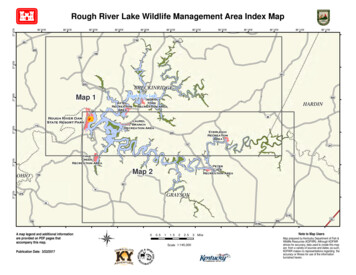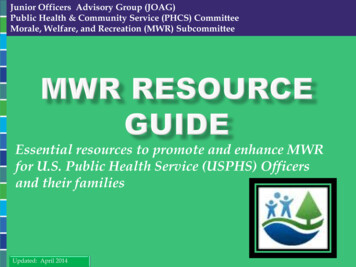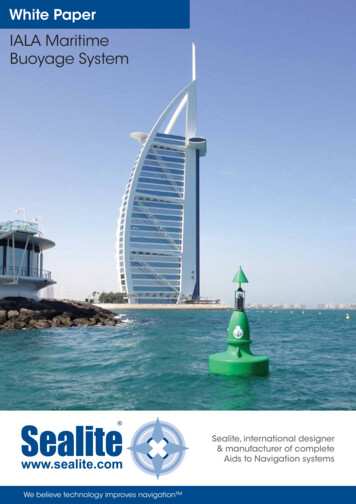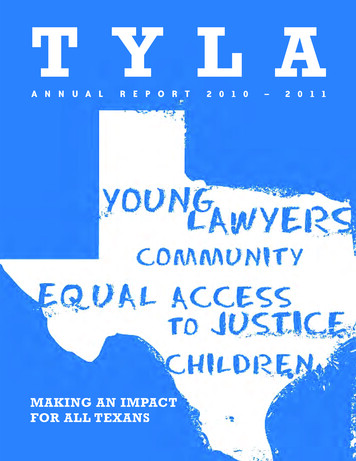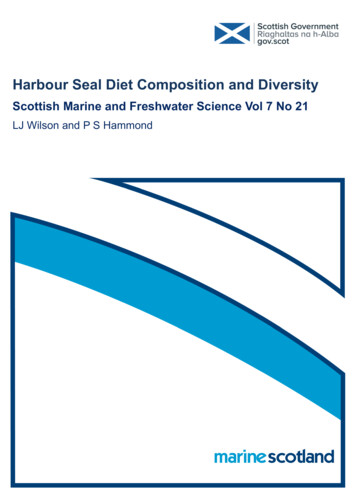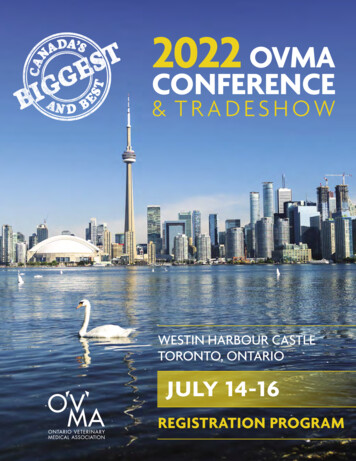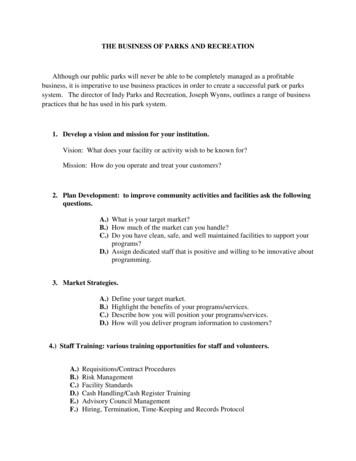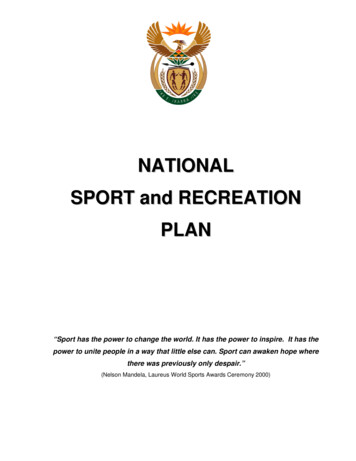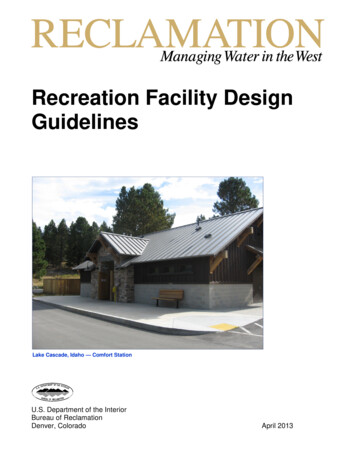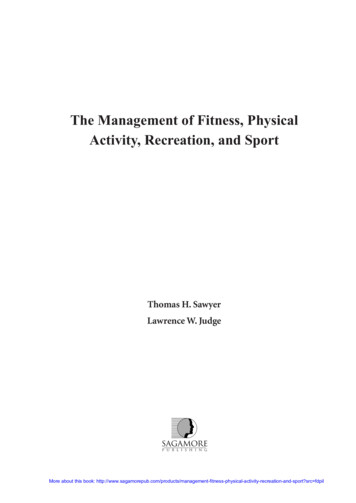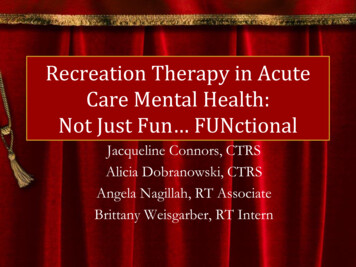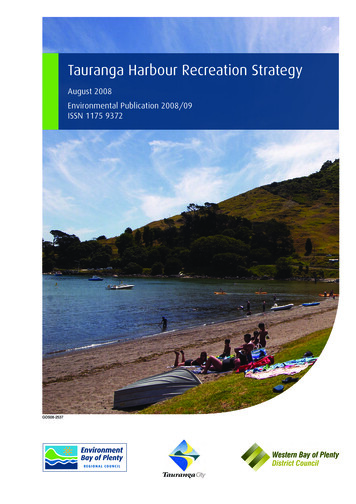
Transcription
Tauranga Harbour Recreation StrategyAugust 2008Environmental Publication 2008/09ISSN 1175 9372GDS08-2537
Environment Bay of PlentyiAcknowledgementsProject Team: Robin Britton, Lauren Schick, Ben Lee,Aileen Lawrie, John Whale, Peter Watson, John Rauputu,and Campbell Larking.Thanks to:Department of Conservation – Rotorua and Tauranga(Chris Staite, Ron Keyser), Environment Bay of PlentyCouncillors and staff, Environment Bay of PlentyHarbourmasterspastandpresent(Jon Moore,John Dickinson and Carl Magazinovic), Forest and Bird(Basil Graeme and Eddie Orsulish), Forest Lady Barge (AbeAuqaha), Heybridge Developments Limited (Ian Dunstan),Historic Places Trust (Rachel Harfield), Hoe Aroha Whanauo Mauao, Hui attendees at Ngati Te Wai, Hui attendees atRereatukahia Marae and Wairoa Marae, Katikati BoatingClub(Keith Pyle),KatikatiSeaScoutGroup(Russell Warner), Maori questionnaire respondents,Maritime New Zealand, (Jim Lott, John Dickinson), Ministryof Fisheries (Craven Dunn, Dave Allen), Northern HarbourAction Team (Sam Dunlop, David Olgilvie, Rosalie Smith,Syd Hopkins), Oceanz City Management (Mandy ScottMackie), Omokoroa Boat Club (John Budden), Port ofTauranga Limited (Nigel Drake, Ian Gorrie), Priority 1(TaurangaEconomicDevelopmentAgency)(Andrew Coker), Respondents to the Tauranga HarbourBeaches Survey, SmartGrowth (Management Group),Tauranga Airport Authority (Ray Dumble), Tauranga BridgeMarina (Tony Arnold), Tauranga City Council Councillorsand staff Tauranga City Council Councillors and staff,Tauranga Game Fishing Club (Ian Thomas), TaurangaMarina Society (Bob Ellis), Tauranga Moana Iwi CustomaryFisheries Committee, Tauranga, Moana Tangata WhenuaCollective (Tauranga City Council), Tauranga Rowing Club(Mark James), Tauranga Yacht Club (Fred Jeanes), TeTawa Quays (Ian Dustin), Toi Te Ora Public Health(Annaka Simpson),WaimarinoRowingClub(Dennis Crowd), Waimarino.com (Blair Anderson and GrantGaffaney), Western Bay of Plenty District CouncilCouncillors and staff, and Western Bay of Plenty DistrictCouncil Maori Forum, Nga whanau no te moutere omatakana/ Matakana Island Resource Management Unit/tangata whenua no Te Awanui.Environmental Publication 2008/09Tauranga Harbour Recreation Strategy
Environment Bay of PlentyiiiExecutive SummaryThis strategy explores the issues for recreation on Tauranga Harbour and sets out a series ofactions to improve recreation opportunities and reduce conflict, while maintaining the quality ofthe environment. It is a joint strategy between Environment Bay of Plenty, Tauranga City Counciland Western Bay of Plenty District Council.The need for the strategy arose from SmartGrowth and the Tauranga Harbour IntegratedManagement Strategy. They identified the impacts of recreation are not well understood, weneed better planning for recreational activities, and planning needs to be a joint effort betweenthe community and the three councils.The vision for the strategy is: “Recreation on Tauranga Harbour is, enjoyable, safe, sustainable,and accessible to all: A set of goals and principles set out how the vision is to be achieved and aframework for decision making.The discussion of the issues and observations for recreation on the harbour are split into fiveareas: harbour margins; navigation safety; boating facilities; the environment; and how we can work together better.The action plan sets out what the three councils will do. Associated with each action is anexplanation, who will lead it, estimated cost and timeframe. Some of the more significant actionsinclude developing an Access Strategy, a designated on-the-water recreation event area,extending the Anzac Bay boat ramp, limiting horse and vehicle access to the foreshore, andsetting up a Recreation Forum.Most of the actions will be implemented as part of existing planned work. For those actions thathave not been planned for, each council will need to consider and adopt them in their respectiveLong Term Council Community Plan (LTCCP) and Annual Plan. The Recreation Forum willmonitor implementation of the actions.Environmental Publication 2008/09Tauranga Harbour Recreation Strategy
Environment Bay of PlentyvContentsAcknowledgements . iExecutive Summary. iiiChapter 1: Introduction .71.1Tauranga Harbour .71.2Recreation .81.3Why do the strategy?. 101.4Who manages recreation?. 11Chapter 2: Where does the strategy fit? . 132.1Community outcomes . 132.2Other plans and strategies. 13Chapter 3: Vision for recreation on Tauranga Harbour . 17Chapter 4: What’s happening now?. 194.1Harbour margins . 194.2Navigation safety . 204.3Boating facilities. 234.4The environment. 254.5How we can work together better . 29Chapter 5: What we will do . 315.1Harbour margins . 325.2Navigation safety . 345.3Boating facilities. 38Environmental Publication 2008/09Tauranga Harbour Recreation Strategy
viEnvironment Bay of Plenty5.4The environment . 405.5How we can work together better. 41Chapter 6: How will the Strategy be implemented?. 45Appendices . 47Appendix 1 – Key Agencies and Documents . 49Appendix 2 – Our Discussions. 51Appendix 3 – Boating on Tauranga Harbour. 53Appendix 4 – Proposed Monitoring Programme . 57Appendix 5 – Bibliography . 61FiguresFigure 1The blue line represents the regional land area and is indicative onlyof the harbour area covered by the Strategy. . 9Figure 2Management of Tauranga Harbour. 15Tauranga Harbour Recreation StrategyEnvironmental Publication 2008/09
7Chapter 1: IntroductionThe Tauranga Harbour Recreation Strategy sets out how we want to manage and enhanceopportunities for recreation on Tauranga Harbour, over the next ten years. It is a joint effortbetween our three councils – Environment Bay of Plenty, Western Bay of Plenty District Counciland Tauranga City Council. This Strategy is a non-statutory document prepared under the LocalGovernment Act, 2002.1.1Tauranga HarbourTauranga Harbour (the harbour) covers an area of 218 square kilometres. Itencompasses the tidal stretch of water between Matakana and the North Islandmainland. At the south eastern end of the harbour is the landmark Mauao and the cityof Tauranga. At the north western end are the small coastal settlements of Athenreeand Bowentown (Figure 1 is indicative of the harbour area covered by this Strategy).There are two main basins within the harbour, joining in the area between MatahuiPoint (on the mainland) and Tirohanga Point (on Matakana Island). These middlereaches are only navigable two hours either side of high tide. At low tide this area is dry– people can walk to and from Matakana Island.The tides have a major influence over how the harbour is used. At low tide 60% of theharbour is very shallow or dry, making deep water a limited resource, but providingextensive exposed areas for a range of ecological and recreational values and uses.Tauranga Harbour is known to tangata whenua as Te Awanui. Te Awanui is the rohemoana of three iwi - Ngāti Ranginui, Ngāi Te Rangi, Ngāti Pūkenga. Most of the maraeof these iwi are located close to the harbour margins. The mauri of the harbour isextremely important for the customary relationship tangata whenua have with theharbour, in particular customary food gathering.Te Awanui – Tauranga Harbour: Iwi Management Plan has been developed and it willbe an important linking document to managing issues on this harbour into the future.Tauranga Harbour is an outstanding natural feature and landscape, an outstandingecosystem for wildlife, including marine mammals, shorebirds and fisheries and isrecognised as a wetland of international importance for wading birds.Environmental Publication 2008/09Tauranga Harbour Recreation Strategy
81.2Environment Bay of PlentyRecreationEvery day people use the harbour for a variety of recreational activities including:Activities involving boats orequipmentSailingRowingPaddling (e.g.Waka ama)KayakingFishingBoatingGame bird huntingKite boardingJet skiingWater skiingDivingWindsurfingWake boardingLand yachtingKite flyingGolfingTauranga Harbour Recreation StrategyActivities not involvingequipmentPassive enjoymentWalking/ / sunbathingFishing from wharves etcShellfish gatheringDog walkingEnjoying views,ambience and openspaceBird watchingEnvironmental Publication 2008/09
Environment Bay of PlentyFigure 19The blue line represents the regional land area and is indicative onlyof the harbour area covered by the Strategy.Environmental Publication 2008/09Tauranga Harbour Recreation Strategy
10Environment Bay of PlentyThe recreational opportunities available on and around the harbour are a significantattraction for people to live in and visit the western Bay of Plenty sub-region. The qualityof the physical environment and leisure/recreation opportunities are two of the top threereasons why people move to this area1.1.3Why do the strategy?It is great that so many people can use and enjoy the harbour. However with more andmore people moving to the western Bay of Plenty sub-region (the population will grow33% over the next 15 years2), there are going to be even more people wanting to enjoyrecreation on the harbour. We want to encourage and provide for this demand, and todo this we need to make sure that: People can easily access the harbour There are opportunities for a wide range of activities The impacts of recreation on the environment are minimised It’s safe for everyoneAn inevitable consequence of high recreational use is conflict - between recreationalusers and with other types of uses, e.g.: People that live around the harbour margins The port Commercial activities (such as ferry and charter services) Marinas Other boat-related service industries Tangata whenua customary activities Flora and fauna in and around the harbourAt the moment conflicts between harbour users are generally limited to high use areas,for example, the southern entrance to the harbour, Pilot Bay and the Sulphur Pointarea. There are still many other areas of the harbour where there is still plenty of spacefor more recreational use.The need for a strategy for recreation on Tauranga Harbour is identified in two existingplanning documents (SmartGrowth and the Tauranga Harbour Integrated ManagementStrategy). Both documents identified that:12 The impacts and needs of recreation on Tauranga Harbour is not wellunderstood. As future use increases, we need better planning for recreational activities andassociated facilities.Reasons for moving into and out of the Bay of Plenty Region, Migration Research Group, University of Waikato, September 2006.Demographic Forecast 2051, Environment Bay of Plenty. August 2006.Tauranga Harbour Recreation StrategyEnvironmental Publication 2008/09
Environment Bay of Plenty 1.411Planning needs to be a joint effort between the community and the three councilsinvolved – Environment Bay of Plenty, Tauranga City Council and WesternBay of Plenty District Council.Who manages recreation?There is a wide range of agencies responsible for managing recreation on and aroundthe harbour - Appendix 1 describes the responsibilities of all the key agencies.Environment Bay of Plenty, Western Bay of Plenty District Council, and Tauranga CityCouncil play the biggest role in managing recreation on the harbour. EnvironmentBay of Plenty is the prime agency with responsibility for managing activities on harbourwaters and making sure the quality of the waters is looked after. Western Bay of PlentyDistrict Council and Tauranga City Council are responsible for managing how andwhere people access the harbour (e.g. boat ramps and reserves). The Ministry ofFisheries is the other main agency – they are responsible for managing fisheriesincluding recreational fishing. The Department of Conservation also has a role inreserve and marginal strip management around Tauranga harbour.Environmental Publication 2008/09Tauranga Harbour Recreation Strategy
13Chapter 2: Where does the strategy fit?2.1Community outcomesEverything that a council does has to contribute to their Community Outcomes.Community Outcomes are focussed on improving social, economic, environmental andcultural wellbeing. Each council has its own ‘set’ of community outcomes which weredeveloped with their communities.The community outcomes of the three councils advocate Tauranga Harbour as beingiconic, highly valued and central to all people and activities occurring in the westernBay of Plenty sub-region. The most relevant community outcomes for the strategy are:Tauranga City Council (Tauranga Tomorrow) The harbour, foreshore and waterways are clean and healthy and supportcompatible cultural, social, economic and recreational opportunitiesWestern Bay of Plenty District Council (Smart Future) We can all enjoy a healthy and safe lifestyle Our environment is clean, green and valuedEnvironment Bay of Plenty (Community Outcomes, the Ten Year Plan 2006-2016)2.2 A clean and protected environment Healthy and safe communities A vibrant and fulfilling lifestyleOther plans and strategiesThe management, development and implementation of strategies and other actionsrelating to Tauranga Harbour need to be implemented in a staged approach, ratherthan trying to address all issues at once. These stages of work will in time, be combinedand provide a key basis for the overall management of the harbour. It is stronglyrecognised that there are many inter-linkages between different harbour managementissues and areas. It is also recognised that some work will be guided by nationalstrategies such as the New Zealand Coastal Policy Statement.Environmental Publication 2008/09Tauranga Harbour Recreation Strategy
14Environment Bay of PlentyThe Recreation Strategy is therefore just one of a number of “tools” used by thecouncils to help manage Tauranga Harbour – as shown in the following diagram (Figure2). This Strategy is a first step in the path to managing current and future recreationdemands that will arise as a result of increased population growth of the sub-region. Assuch it is not a static document, rather one that will be built upon over time. TheStrategy may result in a range of different outcomes. For example, changes to statutorydocuments, education initiatives, operational actions or liaison with other agencies.It is important to also realise that each of the three Councils involved in this Strategymust build the recommended actions into their Long Term Council Community Plans(LTCCP) and annual planning cycles. This will signal their commitment to undertakingthe actions.Tauranga Harbour Recreation StrategyEnvironmental Publication 2008/09
Environment Bay of PlentyFigure 215Management of Tauranga HarbourEnvironmental Publication 2008/09Tauranga Harbour Recreation Strategy
17Chapter 3: Vision for recreation on TaurangaHarbourThe vision is a statement of what we want for recreation on Tauranga Harbour now and into thefuture.Vision:‘Recreation on Tauranga Harbour is, enjoyable, safe, environmentallysustainable, and accessible to all’To achieve this vision, the Strategy sets out six goals. The goals are statements of where weneed to be heading to achieve the vision.Goals: Recreation is a significant use on Tauranga Harbour. People have easy access for recreation on Tauranga Harbour. There are opportunities to experience a variety of recreational activities onTauranga Harbour. Tauranga Harbour is safe and enjoyable for all recreation users. Any adverse effects of recreation on other users, tangata whenuacustomary activities and the environment are avoided or minimised. Management of recreation is co-ordinated, clear and efficient.The principles are the fundamental values that we have about recreation on the harbour. Theywill guide our decisions about what are the best ways to achieve the goals and the vision. Thefollowing principles are not listed in any order of priority.Principles: The recreational opportunities offered by the harbour are an integral part of theeconomic, social, environmental and cultural wellbeing of the community. Access to and along the harbour is vital for providing for recreational opportunities. Education and enforcement are both necessary tools for ensuring safe recreationaluse of the harbour. Surface and deep water space is at a premium and should be used efficiently,having regard to competing uses.Environmental Publication 2008/09Tauranga Harbour Recreation Strategy
18Environment Bay of Plenty Designating areas for specific activities can be a clear and simple way of reducingconflict. The harbour is a public domain available for the use of a wide range of activities. The importance of commercial shipping and transport operations is recognised. The types and popularity of recreation activities are always changing and anymanagement of the harbour must be flexible to meet these changes. Agency partnerships are fundamental to efficiently managing the harbour,particularly where the use of land is closely linked to how the harbour is used. People will always have different expectations and aspirations on use of theharbour and these need to be balanced between different users. A healthy harbour is fundamental for ensuring quality recreation. Recreational uses must not compromise or adversely affect the sustainability of theharbour's natural and physical resources. The three Councils will work in a partnership to maintain and enhance recreationalopportunities, through the implementation of this and other harbour-relatedstrategies. Cultural sustainability and a healthy harbour environment are important for themauri of the harbour. The visual quality of the harbour and its margins is an important part of people’senjoyment of recreational experiences.Tauranga Harbour Recreation StrategyEnvironmental Publication 2008/09
19Chapter 4: What’s happening now?This chapter creates a picture of what is happening now for recreation on Tauranga Harbour. Itbrings together what we know about recreation, from talking with a whole range of people,including: Recreational groups and clubs Individuals that use the harbour Tangata whenua Commercial operators Government departments Council staff(See Appendix 2 for details of who we talked to).Five key themes emerged from our discussions: Harbour margins Navigation safety Boating facilities The environment How we can work together better4.1Harbour margins34.1.1AccessAccess is the single most important factor for providing opportunities for recreation onand around the harbour. To encourage more use of the harbour, we need to make surethat existing access is optimised and where possible, find new ways to access theharbour. There are positive health outcomes for the community associated with easilyaccessing physical activity opportunities.3NB: Issues relating to marinas, moorings, ramps and boating are covered in section 4.3 - Boating facilities.Environmental Publication 2008/09Tauranga Harbour Recreation Strategy
20Environment Bay of PlentyWe need to make sure there are access opportunities for a range of different peopleincluding the elderly, disabled and young children. But we also need to balance thiswith protecting parts of the harbour for their “ecological” values, e.g. kaimoana beds,wetlands and bird roosting areas, and protecting the open space characteristics thatare a fundamental part of the recreational enjoyment of this harbour. Many of theseissues are controlled through the respective bylaws of Tauranga City Council andWestern Bay of Plenty District Council.Both Tauranga City Council and Western Bay of Plenty District Council have a spreadof reserves and facilities (e.g. boat ramps and walkways) around the harbour marginsthat provide access to Tauranga Harbour. Between the Councils there are a suite ofplans and strategies that guide how these reserves and facilities are managed.Access to traditional Maori kaimoana areas and other customary sites in the harbourhas been reduced due to ongoing development around the harbour margins. Many ofthe points of access were by way of long standing informal agreements with privateland owners. Subdivision has seen many of these informal agreements disappear.People’s access to the harbour can have adverse effects on the environment. Forexample people and their dogs can disturb high tide roosting and nesting birds, and theuse of vehicles on harbour beaches and foreshore areas can impact on shellfish beds.The latter example is an emerging issue, particularly in the northern harbour when theramps are busy or are not useable at low tide. Both Tauranga City Council and WesternBay of Plenty District Council have bylaws prohibiting horses on beaches, but nocontrols on vehicles launching boats.Environment Bay of Plenty has identified the need for an Access Strategy (TaurangaHarbour Integrated Management Strategy and Ten Year Plan). The purpose of anAccess Strategy is to have a harbour wide strategic plan for maximising andencouraging access, balanced against the need to minimise the adverse effects ofaccess on the environment (e.g. protection of high tide roosts, or access opportunitiesfor people to go fishing without a boat).4.1.2Future development (non-recreational) zonesBetween the Regional Council and the Territorial Authorities, there has been little jointstrategic planning for developments that straddle land and water (e.g. marinas, boatbuilding/ servicing industries, ferry services, access structures). Consequently there aresome areas where there is limited integration between harbour margin and water basedzonings. This means there is limited guidance for such future developments. Althoughthis is not directly related to recreation issues, any such zoning would impact onrecreational access and use.As examples, the demand for marinas and water-based transport is likely to increase inthe future. These types of development have both land and water based infrastructureand impacts.4.2Navigation safety4.2.1Recreational watercraft activitiesThere has been very little research of watercraft activity on the harbour. The limitedresearch that has been done has looked at the total number recreational boats.Approximately 20% of households in the Tauranga/Western Bay of Plenty Census areahave at least one boat (Maritime Safety Authority, 1999). This equates to 10,400 boatsin 2001 and projected to increase to 15,400 boats by 2021.Tauranga Harbour Recreation StrategyEnvironmental Publication 2008/09
Environment Bay of Plenty21Recreational watercraft activity on the harbour has changed over the last 10 years andis expected to continue to change for the next 10 years. Anecdotal evidence from thosewe talked with suggested the following recent trends: An increase in watercraft activity on the harbour An increase in the popularity of kayaking and waka ama More power boats and yachts using the harbour Jet skis are getting larger and faster; they now operate more like boats Significant growth in youth training activities Significant increase in the popularity of kite boarding and sail boardingEven with the increase in users, many of the people we talked to considered that thereis still plenty of space in the harbour for more recreational watercraft activity. Othershowever considered that space needed to be managed carefully as the channels andshipping movements were important limitations. The increase in recreational use of theharbour has the potential to disturb the habitat for birds.4.2.2Jet ski and ski lanesThere are nine ski lanes and two jet ski lanes in the harbour - refer to Appendix 3 for amap showing their location. During our consultation, many people raised concernsabout: Erosion from the wake of boats and jet skis Effects on shellfish Danger to children swimming People using private land to launch vessels and base their skiing and jet skiingactivities from Conflicts with access to traditional Maori fishing and cultural activity areas The noise and activity can disturb people and in particular Marae ceremoniesInterestingly many of these lanes are located adjacent to Maori land and these issuesare of particular concern to tangata whenua. The location of jet ski and ski lanes isalways controversial. Any review of their location is a part of the Navigation SafetyBylaws review (see below) and would require further discussions with the public.4.2.3Rules and rolesThe Bay of Plenty Regional Navigation Safety Bylaws 2004 (Navigation Safety Bylaws)set out rules about boating on the harbour. They are implemented by EnvironmentBay of Plenty through the Harbourmaster, his deputies and volunteer harbour wardens.The Navigation Safety Bylaws primarily focus on people’s recreational boating use ofthe waters and cover a range of safety provisions (such as life jackets and speed ofvessels), provisions to manage uses (e.g. moorings management) and provisions toavoid conflicts (such as ski lanes).Environmental Publication 2008/09Tauranga Harbour Recreation Strategy
22Environment Bay of PlentyThe Harbourmaster and his deputies enforce the Navigation Safety Bylaws. Many ofthe people we talked to emphasised the importance of an enforcement ‘presence’ onthe water as a deterrent, especially at high use locations and during busy periods. (NB:the volunteer harbour wardens have an education and advisory role not an enforcementrole.).One of the difficulties with following up reported incidents is identifying vessels. Onesolution to this problem is for all recreational vessels to be registered (or otherwiseidentified) and have clearly displayed identification. A report by the Pleasure BoatSafety Advisory Group in 1999 suggested that “registration” of recreational vessels wasnot necessary at that time, because the safety to be gained from such a system wouldnot outweigh the costs of implementing it.Education is important for people’s safety. People need to know the rules. As it’s such alarge harbour and there are lots of users, we can’t just rely on enforcement.Environment Bay of Plenty widely distributes a Harbour Guide which provides a rangeof navigation safety information for users. A number of the people we talked tosuggested that it was people from outside the local area who were the hardest toeducate about safe practices on the harbour.Coastguard, Seacoms and the Port of Tauranga Limited are significantly involved insafe navigation. All three organisations assist boaties, by providing continuous radioservices. The Port provides web-based information (for example shipping movements,swell, and wind direction) for the southern entrance. However there is little informationavailable to boaties and the Coastguard to assist in safe crossings of the northernharbour bar.Interestingly, Coastguard undertakes approximately 10-20 and 70 rescues each year atthe northern and southern harbour entrances respectively. But over the past 10 years,there has been a low level of accidents on the harbour that were reported to MaritimeNew Zealand or to Environment Bay of Plenty.4.2.4Events and commercial operatorsApproximately 180 events are held on the harbour each year. The Navigation SafetyBylaws allow for areas of the harbour to be set aside for special events. The use ofcouncil reserves to support these special events is approved by Tauranga City Counciland Western Bay of Plenty District Council.There have been times when there’s been a lack of coordination between the councilsfor processing and granting approvals for events, due to each council having differentsystems. With increasing use of the Harbour, it would be more efficient to have asystem in place that allows councils to jointly approve events.Spa
Club (Keith Pyle), Katikati Sea Scout Group (Russell Warner), Maori questionnaire respondents, . Marina Society (Bob Ellis), Tauranga Moana Iwi Customary Fisheries Committee, Tauranga, Moana Tangata Whenua . The Ministry of Fisheries is the other main agency - they are responsible for managing fisheries
